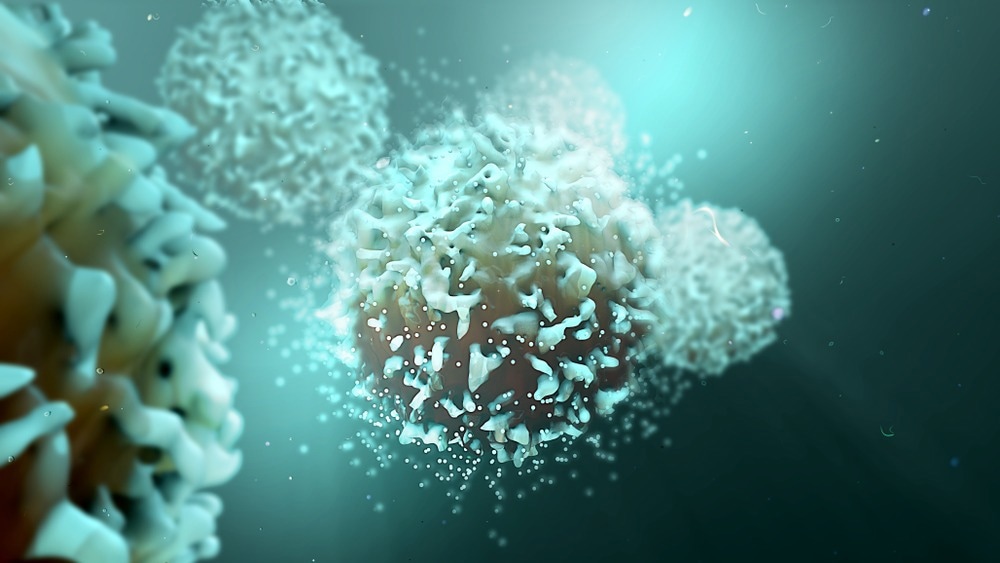In a recent study posted to the medRxiv* preprint server, researchers immunophenotyped T lymphocyte responses among unvaccinated individuals, representative of the entire spectrum of the clinical presentation of coronavirus disease 2019 (COVID-19).
 Study: A unique cytotoxic CD4+ T cells signature defines critical COVID-19. Image Credit: Design_Cells/Shutterstock.com
Study: A unique cytotoxic CD4+ T cells signature defines critical COVID-19. Image Credit: Design_Cells/Shutterstock.com

 *Important notice: medRxiv publishes preliminary scientific reports that are not peer-reviewed and, therefore, should not be regarded as conclusive, guide clinical practice/health-related behavior, or treated as established information.
*Important notice: medRxiv publishes preliminary scientific reports that are not peer-reviewed and, therefore, should not be regarded as conclusive, guide clinical practice/health-related behavior, or treated as established information.
Background
COVID-19 had varied clinical presentations, ranging between asymptomatic infections and fatal infections. Neutralizing antibody (nAb) titers are associated with immunity against severe and symptomatic severe acute respiratory syndrome coronavirus 2 (SARS-CoV-2) infections.
However, the role of T-lymphocyte responses and cell-mediated immunity in preventing COVID-19 progression is not clear, the assessment of which could inform next-generation SARS-CoV-2 vaccine development.
About the study
In the present study, researchers reported on the immunological cytotoxic cluster of differentiation 4+ (CD4+) T lymphocyte signature of critical COVID-19.
Peripheral blood mononuclear cell (PBMC) samples were obtained from polymerase chain reaction (PCR)-confirmed COVID-19 patients and subjected to spectral cytometry analysis. Manual and computational analyses were performed to detect T lymphocyte populations related to distinctive disease states via non-biased clustering, discriminant analysis, and principal component analysis (PCA).
The team explored T lymphocyte populations that might be involved in COVID-19 progression of severity using partial least squares discriminant analysis (PLS-DA). Memory and naïve lymphocyte subset distribution was explored among CD4+ non-follicular helper T lymphocyte and CD8+ T lymphocyte compartments.
Further, the proportions of cytotoxic CD4+ T lymphocytes and CD8+ T lymphocytes were correlated to determine whether CD4+ cytotoxicity might compensate for CD8+ T lymphocyte exhaustion. A phenotypic analysis of T lymphocyte responses was performed for individuals with asymptomatic to critical COVID-19.
Results
Critical COVID-19 was characterized by the elevated cytotoxic and activated type of CD4+ T lymphocyte of T follicular helper (TFH) type or the effector memory re-expressing CD45RA (TEMRA) phenotype. The CD4+ cytotoxic T lymphocytes (CTLs) were rarely present among severe COVID-19 patients. Contrastingly, mild or asymptomatic COVID-19 was related to elevated percentages of non-activated or naïve type of T lymphocytes and lowered activation marker expression.
The proportions of CD8+ CD45RO- and C-C chemokine receptor type 7+ (CCR7+) cells and CD4+, CD45RO-, and CCR7+ cells were found to be significantly higher among severe COVID-19 patients than those with critical infection, denoting naïve or inactivated (TN) CD8+ T lymphocytes and CD4+ T lymphocytes, respectively. The findings indicated that critical COVID-19 was characterized by a shift from naïve T lymphocyte phenotypes to cytotoxic CD4+ T lymphocyte subset expansion.
The proportion of circulating programmed cell death protein-1 (PD-1+) CCR7- TFH lymphocytes (cTFH) was greater among critical COVID-19 patients. Cytotoxic CD4+ T lymphocytes comprised 3.70% of lymphocytes among critical COVID-19 patients and 0.4 to 1.3% among all other COVID-19 patients. In the compartment of CD4+ non-follicular helper T lymphocytes, greater proportions of CD4+ TEMRA lymphocytes expressing granzyme B (GZMB+) and perforin (PFN+) were observed among critical COVID-19 patients.
Critical COVID-19 patients showed elevated percentages of CD8+ TEMRA lymphocytes and lowered proportions of CD4+ TN lymphocytes compared to patients with mild or severe COVID-19. In addition, critical COVID-19 patients showed elevated human leukocyte antigen-DR isotype (HLA-DR) expression on CD4+ TEMRA cells compared to individuals with mild or asymptomatic COVID-19, with considerably greater proportions of CD8+ TEMRA lymphocytes expressing PD-1, with COVID-19 progression.
The findings indicated that cytotoxic CD4+ TEMRA and cTFH lymphocyte expansion was characteristic of critical COVID-19. The increased HLA expression among respiratory epithelial cells provides a probable mechanistic basis for the contribution of CD4+ CTLs in host tissue injury associated with acute respiratory distress syndrome (ARDS) among individuals with SARS-CoV-2 infections.
There was no change in percentages of CD8+ GZMB+ PFN+ subsets across COVID-19 severities, indicating that CD8+ CTL exhaustion, if present, was not a characteristic feature of COVID-19 progression. The T lymphocyte compartment was distinctly altered among critical COVID-19 patients, with expanded effector memory cell subsets and elevated expression of cytotoxic and activation functional type of markers on CD4+ T lymphocytes. The findings indicate a probably pathogenic contribution of the cytotoxic type of CD4+ CTLs in COVID-19 progression.
Conclusion
The study findings showed that highly activated and cytotoxic clusters of differentiation 4+ T lymphocyte responses might contribute to cell-mediated host tissue injury and COVID-19 progression. The probability for induction of the detrimental T lymphocyte responses must be considered while developing and executing effective SARS-CoV-2 containment strategies.
Since data on cytotoxic cTFH in SARS-CoV-2 infections are limited, the implications of cytotoxicity in cTFH lymphocytes need further analysis evaluating the probable detrimental effects that cTFH lymphocytes might have on anti-SARS-CoV-2 humoral immunity responses.

 *Important notice: medRxiv publishes preliminary scientific reports that are not peer-reviewed and, therefore, should not be regarded as conclusive, guide clinical practice/health-related behavior, or treated as established information.
*Important notice: medRxiv publishes preliminary scientific reports that are not peer-reviewed and, therefore, should not be regarded as conclusive, guide clinical practice/health-related behavior, or treated as established information.